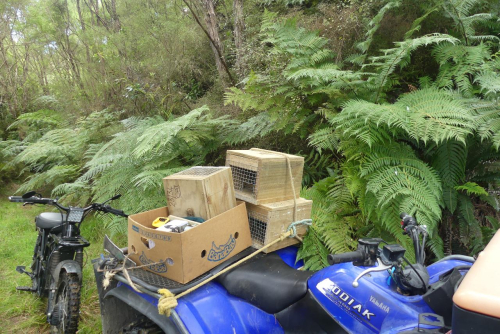
Doug and Gill Snelling from Waiparere Farm were one of the successful recipients of the 2023 Environmental Enhancement Contestable Fund - made possible by support from the Hawke's Bay Regional Council and DOC. We asked Doug how being a recipient has helped them with achieving their goals...
What are the goals of your group?
Waiparere Farm is a 181 hectares (450 acres) property in the Wairoa district, it was a working farm previous to our ownership which began in the early 1990’s. Since then we have taken it upon ourselves to establish a number of QEII covenants which at present take in just over 90 hectares of the property. It is our intention to place almost the entire property (166 hectares/410 acres) under QEII covenant protection before the end of this year.
Our main goals are to allow the land to revert and heal back to a natural state, similar to how it was before human settlement, and as such, become an area of high native biodiversity.
Waiparere is unique to the district in that it has a series of wetlands and is bounded by two large streams fed by smaller headwater streams. As a result of the bush and wetland covenants it has a growing richness of biodiversity. Initially, our motivation for protecting the land focussed on the establishment of habitat for native birds but has since expanded into a more comprehensive focus on the diversity of species that the covenanting and consequent regeneration has encouraged.
We have recorded these species of significance on Waiparere: Peripatus novaezealandiae, Banded Kokopu, Fresh water koura, 10 species of Odonata (an insect group that includes dragonflies and damselflies) including the seldom seen Antipodochlora braueri, long finned eel, Australasian bittern, Marsh and Spotless Crake, Pittosporum obcordatum. Coprosma pedicellata and Clianthus maximus have recently been introduced onto Waiparere by Malcolm Rutherford, QEII rep, and Helen Jonas, DOC field officer. Over 500 genera of fungi on Waiparere have been recorded and identified on iNaturalist. A comprehensive photographic record of flora and fauna has been maintained to record the change in biodiversity.
How has the Fund helped you achieve these objectives?
Pest control has been an ongoing concern and focus for us from the time of the establishment of our first covenant.
All of our covenanted land has been deer and goat proofed with an electric fence design first used on our property (since revised and improved) and now required on all covenants in the East Coast area. It has been an effective way to manage goats and deer, but we have struggled with a small handful of elusive deer.
Part of our Biodiversity HB Environmental Enhancement Fund application was for a professional pest control hunter, Wayne Looney, to spend four days in our covenants. Wayne worked in sometimes troubling weather conditions and was able to cull some, but not all deer and a number of goats. He was also able to offer valuable strategies regarding future culling.
Controlling possums, rats, stoats, rabbits, hedgehogs and cats has involved a different approach. A wide-ranging placement of DOC 200 and NZ Autotraps traps in the covenanted/regrowth areas is essential to the control of such pests. Our pest control effort has been ongoing for the past 23 years.
We have been able to purchase and place another 43 DOC traps and 8 NZ Autotraps as a result of our successful Biodiversity HB Environmental Fund application this year. These additional traps have allowed us to build up a network of 123 DOC traps and 14 NZ Autotraps to fight the constant presence of pests on our property.


29 November 2023
Disclaimers and Copyright
While every endeavour has been taken by the Hawke's Bay Regional Council to ensure that the information on this website is
accurate and up to date, Hawke's Bay Regional Council shall not be liable for any loss suffered through the use, directly or indirectly, of information on this website. Information contained has been assembled in good faith.
Some of the information available in this site is from the New Zealand Public domain and supplied by relevant
government agencies. Hawke's Bay Regional Council cannot accept any liability for its accuracy or content.
Portions of the information and material on this site, including data, pages, documents, online
graphics and images are protected by copyright, unless specifically notified to the contrary. Externally sourced
information or material is copyright to the respective provider.
© Hawke's Bay Regional Council - www.biodiversityhb.org / 027 231 9367 / info@biodiversityhb.nz